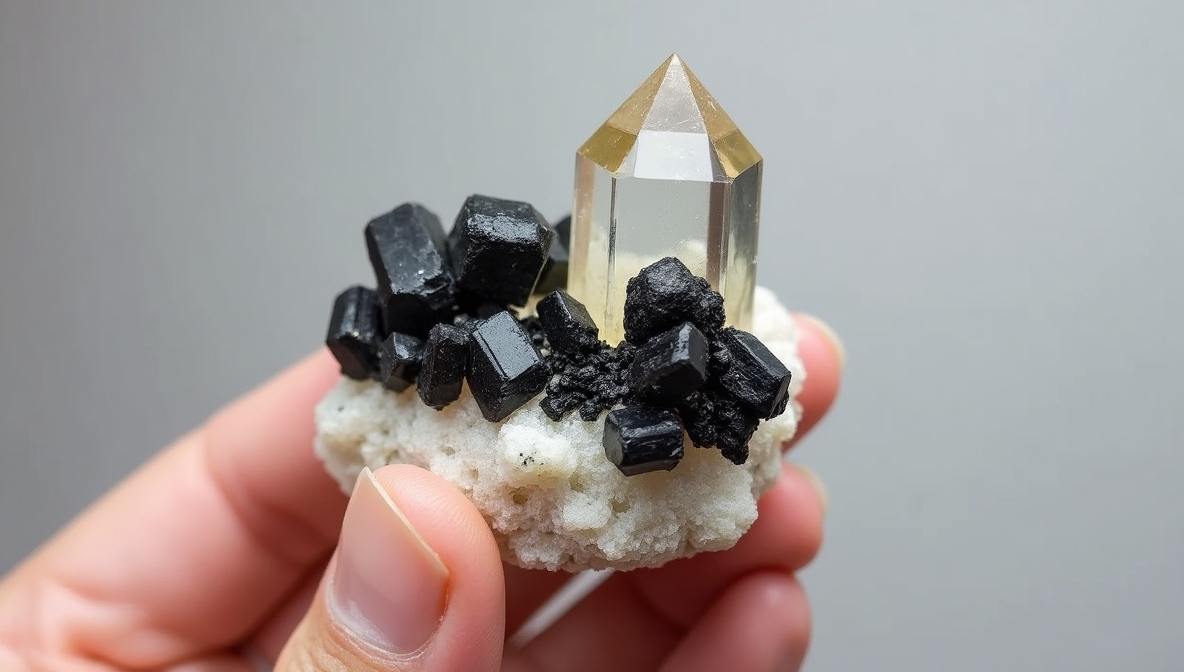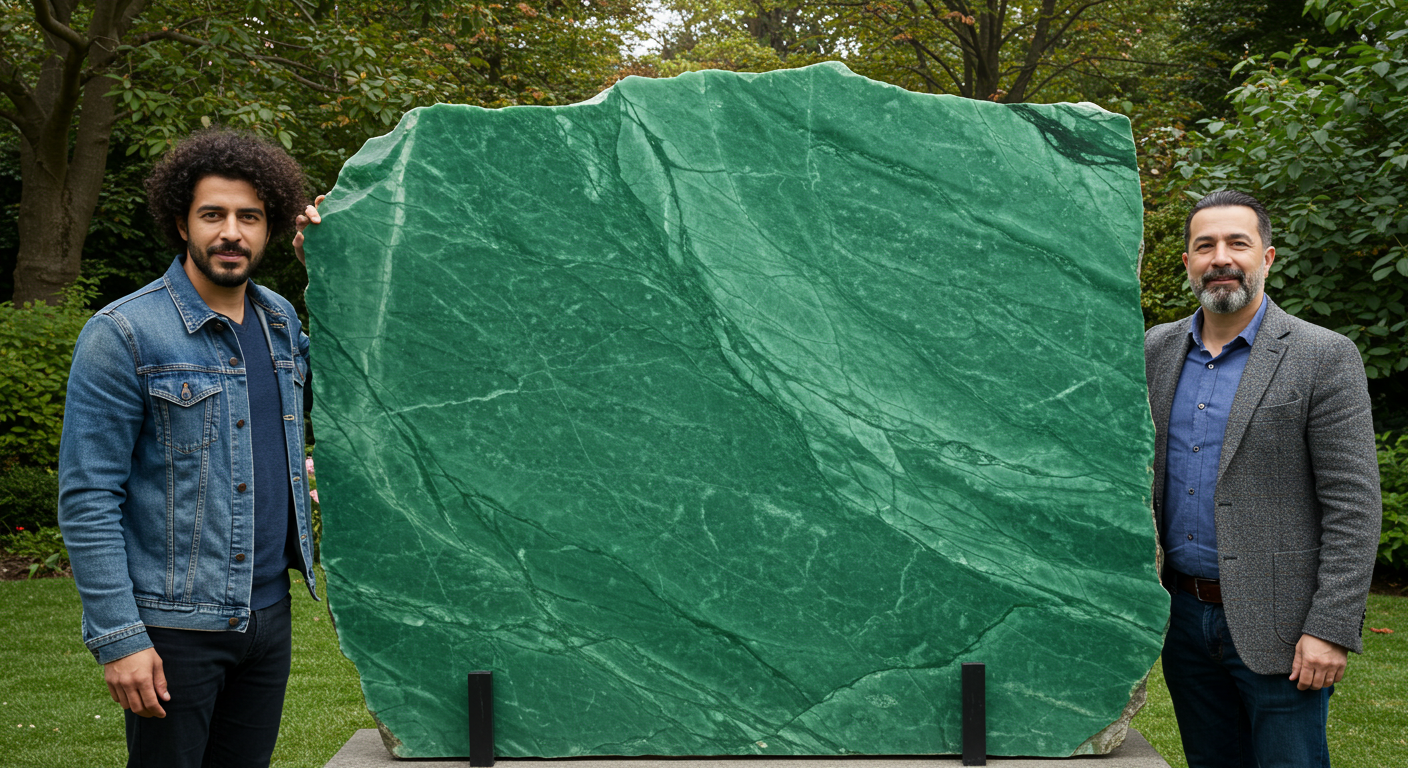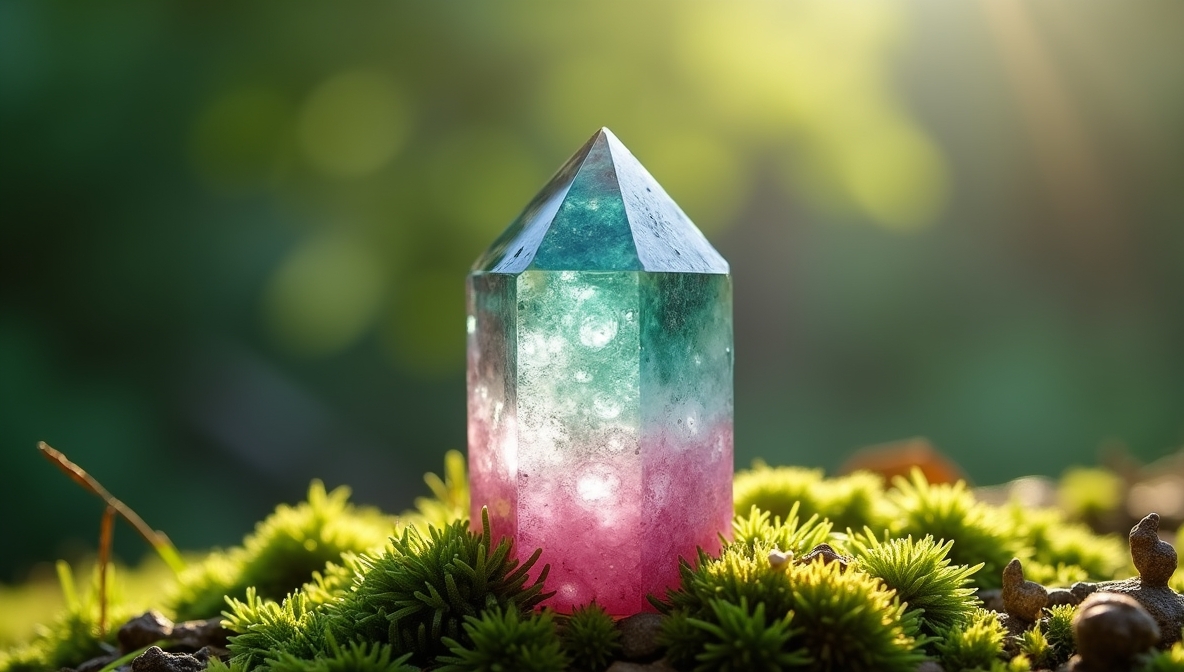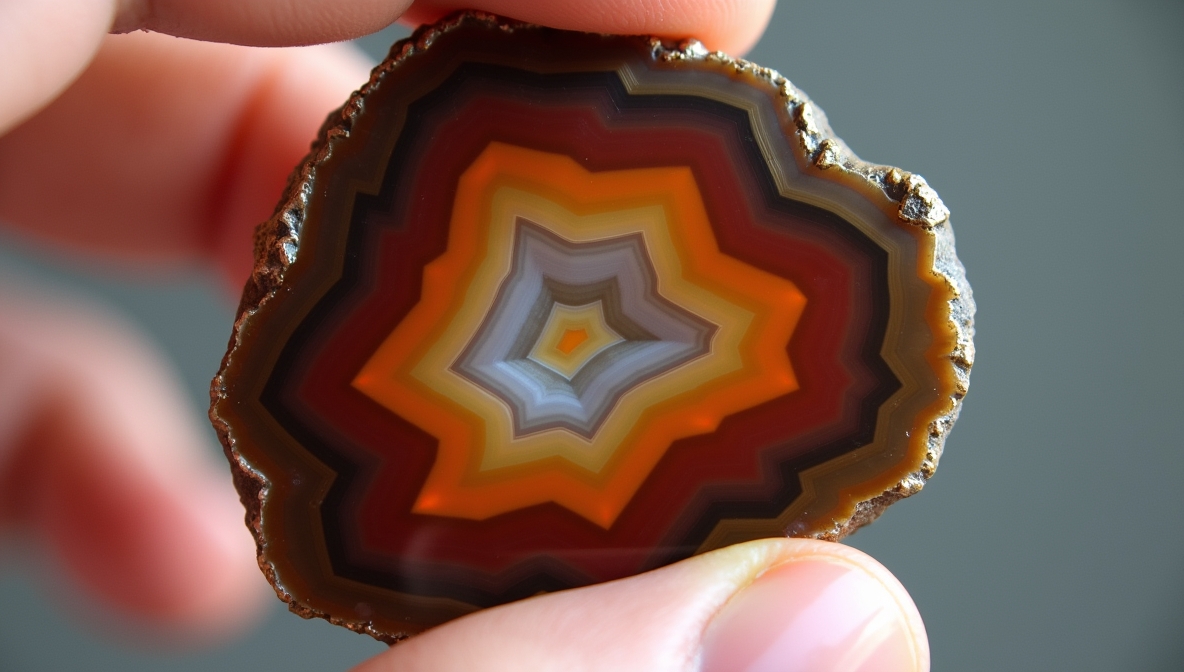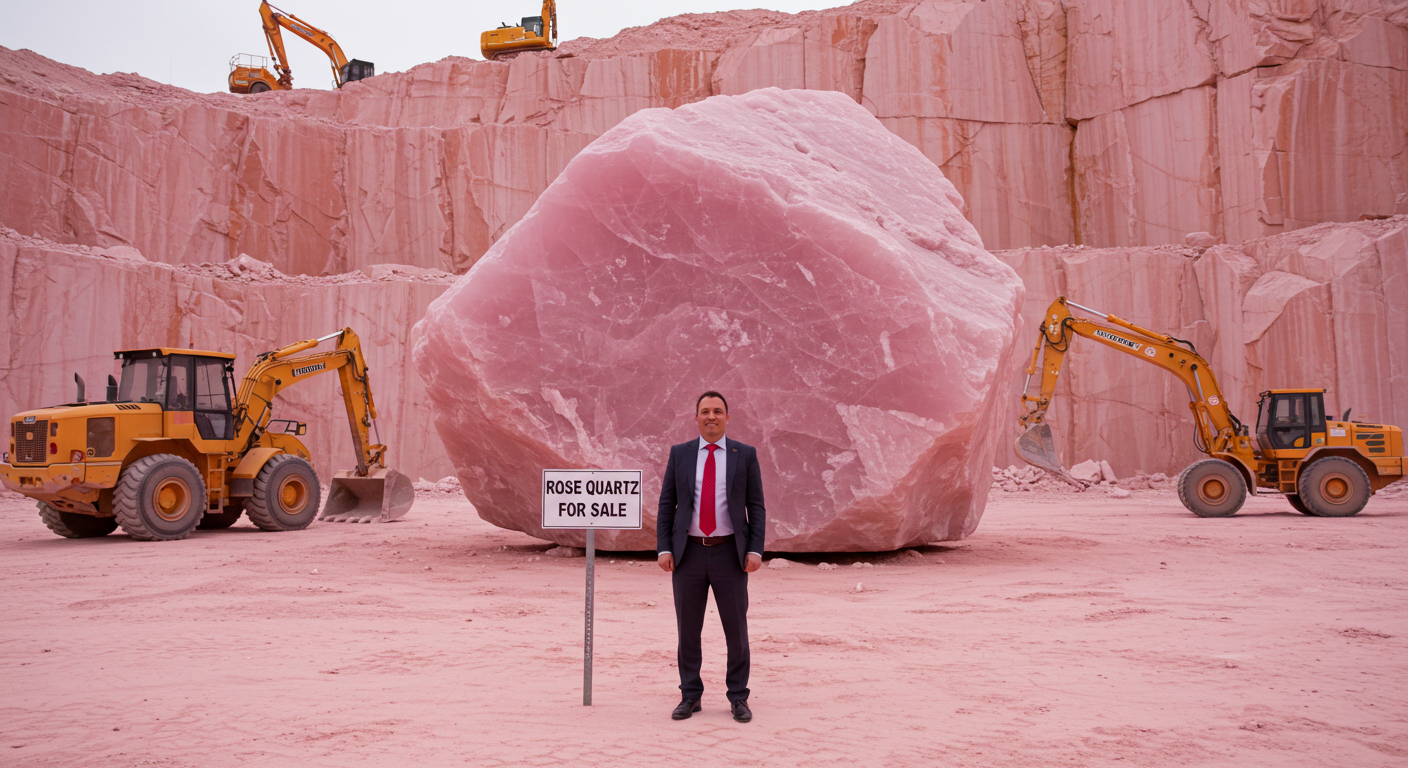See this incredible The Narrative Captured in Quartz, Tourmaline, and Albite. Explore its intricate patterns and natural beauty.
Look closely at the image. It’s a moment frozen in time, not just by the camera shutter, but by the slow, deliberate hand of geological process itself. We see a human hand, warm and organic, gently cupping a piece of the deep Earth. Sharp focus draws our eye to the intricate details of the specimen: a commanding, clear quartz crystal, hosting and intertwined with sleek black tourmaline, all resting on a bed of sparkling white druzy albite. The plain light grey background removes distraction, allowing the natural forms and colors to sing, illuminated by the soft, revealing touch of natural lighting.
This isn’t merely a photograph of some rocks; it’s a carefully composed portrait of a geological relationship, a study in contrasts, and a tangible connection to the ancient, fiery forge beneath our feet. It’s a piece that encapsulates millions of years of history, brought into the light and shared through the lens. Let’s delve into the layers of story held within this close-up view.
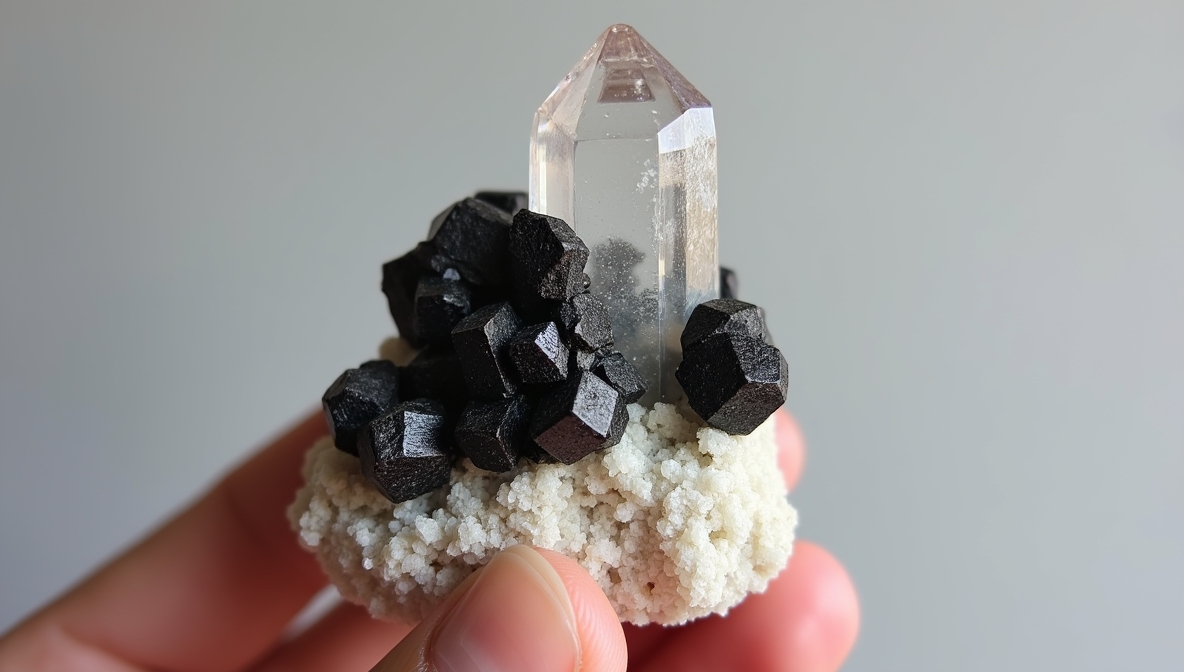
The Specimen: A Trio in Time and Texture
The heart of the image is the mineral specimen itself – a natural sculpture composed of three distinct mineral personalities:
- The Clear Quartz Crystal: Dominant, elegant, and transparent. Quartz (SiO₂) is the quintessential crystal, often forming in perfect hexagonal prisms with sharp, pyramidal terminations. In this specimen, the quartz is described as “large” and “terminated,” suggesting a significant, well-formed crystal that had the space and conditions to grow into its ideal shape. Crucially, it’s “clear,” meaning light passes through it unimpeded. This clarity is vital, as it allows us to see into the crystal, revealing any secrets held within its structure. Clear quartz speaks of purity, order, and unobstructed growth. Its faceted surfaces catch and refract light, adding sparkle and defining its precise geometry.
- The Black Tourmaline Crystals (Schorl): The dramatic counterpoint. Black tourmaline, specifically the iron-rich variety known as Schorl, is opaque and intensely black. Tourmaline crystals are typically prismatic, often with distinctive rounded triangular cross-sections and vertical striations etched along their length. The description notes “multiple” black tourmaline crystals, some “intergrown” with the quartz, and potentially “included” (though the prompt emphasizes intergrown, inclusions are a common, related phenomenon in such specimens).
- Intergrown: This is a key term. It signifies that the tourmaline didn’t just land on the quartz; they grew simultaneously or in close sequence, sharing the same space and fluids. The tourmaline crystals punch through, run alongside, or are partially enveloped by the quartz, creating a dynamic, interwoven structure. This intergrowth tells a specific geological story about the shared environment and timing of their crystallization.
- Included: If some tourmaline crystals are fully suspended within the clear quartz, they become inclusions. These are like ancient artifacts trapped in crystal amber, perfectly preserved within the quartz lattice. Black needles or fragments encased in clear quartz (often called Tourmalinated Quartz) are visually striking and confirm that the tourmaline was present and growing before or during the final stages of the quartz crystal’s growth. The opacity of the black tourmaline against the clarity of the quartz creates a stunning visual contrast, emphasizing both minerals’ forms and textures.
- The White Druzy Albite Matrix: The foundation, the stage. Albite (a type of plagioclase feldspar, NaAlSi₃O₈) is a common mineral, often found as part of the matrix in mineral specimens. In this case, it’s described as “white” and “druzy.”
- White: Like the grey background, the white matrix provides a neutral, contrasting base. It allows the black tourmaline and the clear quartz to stand out vividly.
- Druzy: This refers to a surface covered with a layer of small, microcrystalline crystals. Imagine a surface coated in tiny sugar-like crystals that sparkle and catch the light. This texture adds a different dimension – a fine sparkle and granular appearance that contrasts with the smooth, larger faces of the quartz and the striated surfaces of the tourmaline. It suggests a phase of slower, surface crystallization onto the matrix base. The Albite matrix tells us where these crystals began their journey, anchored to a pre-existing mineral surface deep within the Earth.
Together, these three minerals form a miniature ecosystem of crystallization. The white druzy albite forms the bedrock, from which the clear quartz and black tourmaline ascended and interwove, creating a complex, visually stunning piece that speaks of simultaneous, competitive, and complementary growth.
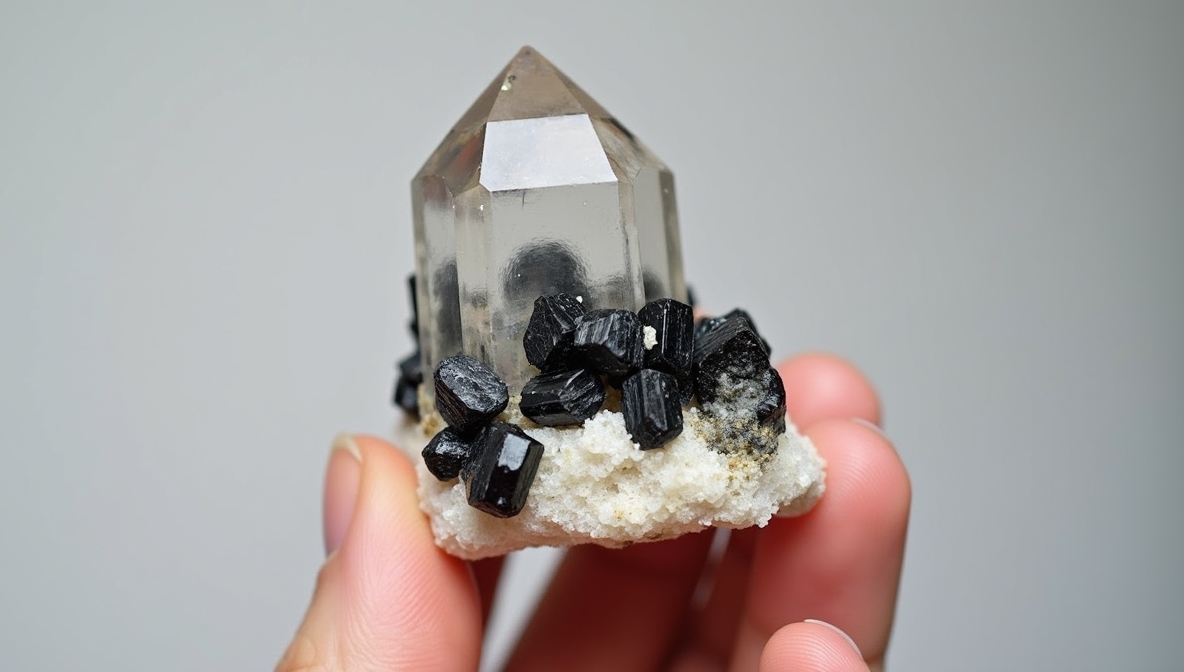
The Human Connection: Held in the Hand
The presence of the human hand is far from incidental; it’s a crucial element of the photograph’s narrative and impact.
- Scale and Tangibility: The hand instantly provides scale. We understand the size and weight of the specimen in a way a ruler or scale bar cannot convey. It makes the specimen feel real, something that can be held, examined, and appreciated directly.
- Relationship and Care: The gentle way the hand cups the specimen suggests care, appreciation, and a connection between the human and the mineral. It’s not just an object on display; it’s being presented, shared, and protected.
- Bridging Time: The warm, soft, temporary flesh of the hand cradling the cold, hard, ancient stone creates a powerful juxtaposition. It highlights the immense difference in timescale – the fleeting moment of a human life connected to a mineral that took millennia to form and has existed for millions of years. It’s a physical link across deep time.
- Aesthetic Contrast: As with the mineral components, the organic curves, texture, and skin tone of the hand provide a soft, natural contrast to the sharp angles, crystalline textures, and stark colors of the mineral. It adds warmth and life to the composition.
The hand transforms the photo from a scientific documentation into a story about discovery, appreciation, and the human desire to connect with the natural wonders of our planet.
The Art of Revelation: Photography Choices
The photographic details specified – close-up, sharp focus, plain light grey background, natural lighting – are not arbitrary. They are deliberate choices that enhance the viewing experience and highlight the specimen’s qualities.
- Close-up: This perspective allows the viewer to get intimate with the specimen. It focuses on the details – the perfect termination of the quartz, the striations on the tourmaline, the sparkle of the druzy albite, the way the minerals intergrow, and the precise point where the hand meets the stone. A close-up reveals the miniature landscapes and intricate structures that would be lost in a wider shot.
- Sharp Focus: Essential for clarity and detail. Every facet, edge, inclusion, and crystalline surface is rendered with precision. Sharp focus allows the viewer to visually explore the specimen’s textures and forms as if examining it up close with their own eyes. It emphasizes the natural perfection of the crystals and the complexity of their intergrowth.
- Plain Light Grey Background: A neutral backdrop is critical for specimen photography. A light grey is soft, non-distracting, and doesn’t introduce competing colors. It allows the true colors of the minerals (the clear quartz, black tourmaline, and white albite) to stand out without distortion or color cast. It emphasizes the specimen as the sole subject, giving it full visual weight.
- Natural Lighting: This is a powerful choice. Natural light (like diffused daylight) tends to be softer and more even than artificial light, especially direct flash or spotlights.
- Softness: Minimizes harsh shadows that could obscure details or create unnatural contrasts. It wraps gently around the crystals, revealing their forms and textures.
- Evenness: Illuminates all parts of the specimen relatively equally, preventing some areas from being blown out (too bright) or lost in shadow.
- Authenticity: Natural light reveals the true color and luster of the minerals as they would appear in natural conditions (albeit bright ones). It avoids the potential color shifts or artificial sheen that some artificial lights can produce.
- Transparency/Clarity: For the clear quartz, natural light penetrates beautifully, illuminating the internal structure and any inclusions without causing excessive, distracting internal reflections.
- Luster: It accurately showcases the vitreous (glassy) luster of quartz, the sub-vitreous to resinous luster of tourmaline, and the potentially pearly or vitreous luster of albite.
The combination of these photographic techniques creates an image that is both highly detailed and aesthetically pleasing, serving as an ideal representation of the specimen’s natural beauty and geological story.
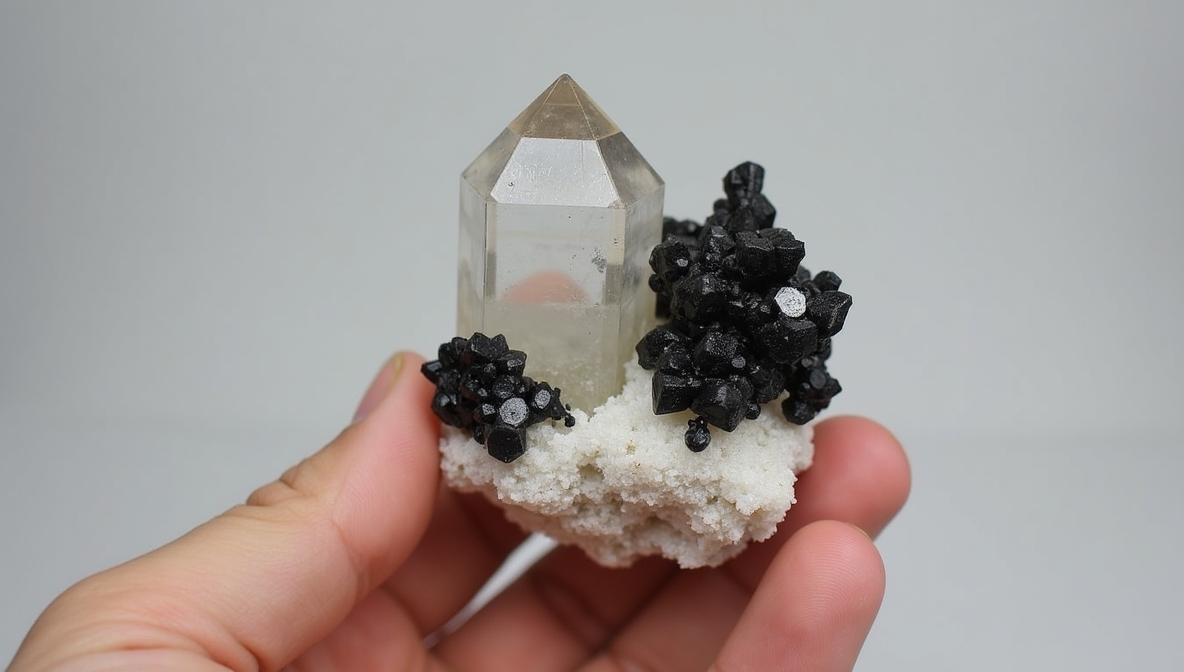
The Geological Narrative: A Pegmatite Dream
This specific mineral association – large, clear quartz, black tourmaline (Schorl), and albite feldspar – is highly characteristic of a particular geological environment: granite pegmatites.
Pegmatites are igneous rocks that form from the last, water-rich stages of magma crystallization. As a body of granite magma cools and solidifies, residual fluids containing concentrated dissolved elements, including those that don’t fit easily into the common rock-forming minerals, are pushed into fractures or cavities. These fluids are very hot and often contain high concentrations of silica, alkali metals (like sodium for albite), aluminum, boron (essential for tourmaline), and sometimes rarer elements.
In these fluid-rich environments, crystals can grow rapidly and to very large sizes because the fluid allows ions to move freely and attach to the growing crystal surfaces.
The likely story of this specimen began millions of years ago:
- Hot, mineral-rich fluids filled a cavity or fracture within cooling granite.
- Albite feldspar began to crystallize first, lining the walls of the cavity and forming the base – the “matrix.”
- As conditions continued to change (perhaps temperature dropped or pressure decreased), silicon, oxygen, boron, iron, and other elements reached saturation.
- Quartz and tourmaline began to crystallize from the same fluid. Because they grew simultaneously in the same confined space, they intergrew, competing for room. The quartz grew into large prisms, sometimes engulfing smaller, already-formed tourmaline crystals (inclusions) or growing around larger tourmaline crystals (intergrowth).
- As the cavity cooled further and the fluids were depleted, crystallization ceased, leaving behind the magnificent cluster of intergrown crystals resting on the albite matrix.
- Over vast stretches of time, geological forces brought this pegmatite vein closer to the surface, where erosion or human activity eventually exposed it.
This specimen is a direct record of that specific, dynamic moment of crystallization within a pegmatite or hydrothermal vein – a testament to the power and patience of Earth’s internal processes.
Beyond the Image: Significance and Appreciation
Why does an image like this, and the specimen it depicts, resonate so deeply?
- Natural Artistry: It is a stunning example of nature’s ability to create objects of incredible beauty, form, and complexity without any human intervention. The interplay of geometric forms, colors, and textures is aesthetically captivating.
- Geological Storytelling: It’s a tangible piece of Earth’s history, telling a specific story about mineral formation, environmental conditions, and the passage of geological time.
- Scientific Insight: Such specimens are invaluable for mineralogists and geologists studying crystal growth, mineral associations, and the environments in which they form.
- Symbolism: Quartz is often associated with clarity and energy; black tourmaline with grounding and protection; feldspar with foundation and structure. Their combination can evoke concepts of structured energy, grounded clarity, or the beautiful complexity that arises from disparate elements.
- Rarity and Value: While the individual minerals are common, specimens with this level of clarity, form, size, and aesthetic intergrowth on a clean matrix are rare and highly sought after by collectors and museums.
The close-up photo, held in a human hand under natural light, maximizes our ability to appreciate all these facets – the scientific, the aesthetic, and the deeply human connection to the natural world.
Conclusion: A Window to Deep Time
The image of a hand holding a mineral specimen featuring a large, terminated clear quartz crystal intergrown with multiple black tourmaline crystals, on a white druzy albite matrix, captured in sharp focus with natural lighting against a plain light grey background, is a profound visual narrative.
It’s a geological document, illustrating the specific conditions within a pegmatite vein millions of years ago where silica, boron, iron, and sodium crystallized together in a complex, intergrown dance. It’s a work of natural art, showcasing the striking contrasts of form, color, and texture between crystalline quartz, opaque tourmaline, and sparkling druzy albite.
And significantly, it’s a human story. The hand reminds us of our role in discovering, appreciating, and safeguarding these natural treasures. The careful photography is an act of sharing, allowing viewers to connect intimately with a piece of deep time, bridging the immense gap between ancient geological processes and contemporary human wonder.
This specimen, held in the hand and captured in light, is more than just minerals; it is a crystallized moment of Earth’s history, a natural masterpiece, and an invitation to marvel at the enduring beauty and profound stories held within the very rocks beneath our feet. It is a piece of the planet, presented for us to admire, study, and connect with, revealing the hidden complexity and stunning artistry of the geological world.
